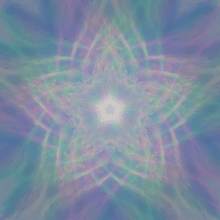Sunburst (community)
 Sunburst image, a common symbol in both pagan and Christian religions | |
| Leader | Norman Paulsen |
|---|---|
Sunburst began as an intentional spiritual community in the late 1960s, inspired by an idea for self-sustaining World Brotherhood Colonies envisioned by Paramahansa Yogananda, the Indian yogi and author of Autobiography of a Yogi and founder of Self-Realization Fellowship.[1][2] It was founded and led by Norman Paulsen and in its prime one of the largest shippers of organic products in the United States.[3] Founded near Santa Barbara, California, the Sunburst members believed in a holistic lifestyle based on meditation, living from the land, organic farming, and – to some degree – chastity.[4]
Their religion can best be described as a mixture of mysticism, Christianity, and the practice of Kriya Yoga. The group later incorporated Hopi rituals and symbolism into their ceremonies. During their early years, they referred to themselves as the “Brotherhood of the Sun.”[5]
Early Sunburst
Norman Paulsen, who started the Sunburst community in the late 1960s as a small group, was a direct disciple of Paramahansa Yogananda, author of the spiritual classic, Autobiography of a Yogi. The group met in a trailer in Santa Barbara to practice meditation. When they outgrew that location, they moved to an old ice cream factory. In 1971, the group bought the Ogilvy Ranch approximately 150 acres (0.61 km2) north of Santa Barbara and renamed it Lemuria. They grew and sold organic vegetables to bring in revenue.
At one time, the Lemuria property grew wheat, corn, and vegetables. Sunburst members planted orchards and vineyards and used Percheron horses to pull their plows. Goats provided milk and cheese; bee hives provided honey. Lemuria even had a blacksmith and a school for members’ children.[5]
In 1974, the Los Angeles Times published a feature article about the founder and his organic farming business. The Times said the following about the community, the office, a converted ice cream factory, is headquarters for a unique brotherhood and business that includes four ranches, three organic food markets, a bakery, two restaurants, a trucking service, and a 158-foot (48 m) sailing vessel being restored at San Pedro.[6]The group flourished, growing to over 300 members, and in 1976 they were able to purchase the 3,000-acre (12 km2) Tajiguas Ranch north of Santa Barbara as a lease option. They also opened a restaurant nearby that incorporated their organic produce into the menu (the business closed five years later). During this time period, Sunburst Farms, as the business was called,[3] owned several local businesses, including a bakery, juice factory, and several food stores.[5]
Part of this was documented by two members of the group, Dusk and Willow Weaver. The married couple's joint journal won the “Best Non-Fiction Award” at the Santa Barbara Writers Conference and was later published by AVANT Books in 1982 with the title Sunburst: A People, A Path, A Purpose.[4]
By the late 1970s, internal disagreements led to the Sunburst community losing two-thirds of its members. The Lemuria property was put on the market, and its population moved to the Tajiguas ranch.[5]
References
- ↑ Yogananda, Paramahansa, Autobiography of a Yogi. Third edition, 1951.
- ↑ Self-Realization Fellowship (November 1995). Open Letter. Self-Realization Fellowship.
- 1 2 Corwin, Miles (July 10, 1989), "20 Years Later, Some Followers of Guru Still Keep the Faith," Los Angeles Times
- 1 2 Weaver, Dusk and Willow. (1982), Sunburst: A People, A Path, A Purpose: The Story of the Most Provocative Communal Group in America Today, San Diego, California: Avant Books ISBN 0932238165
- 1 2 3 4 Beresford, Hattie (July 5, 2007), "The Way It Was: The Many Faces of Ogilvy Ranch," Montecito Journal
- ↑ Russell Chandler (1974-02-03). "Sun Shines Bright on Brotherhood: 'Dream' Bears Fruit -- and Vegetables and Profits". Los Angeles Times.
Further reading
- Duquette, Susan. (1978), Sunburst Farm Family Cookbook, Santa Barbara, CA: Woodbridge Press Publishing Company ISBN 0912800607
- Hansen-Gates, Jan (Winter 1975-76), "Growing Outdoors: The Brotherhood of the Sun," Santa Barbara Magazine 1, no. 3:64-71.
- Paulsen, Norman (2002), Christ Consciousness, Solar Logos Foundation, ISBN 978-0941848091
External links
- Official website
- (LA Times Article about Brotherhood of the Sun, 1989) http://articles.latimes.com/1989-07-10/news/mn-2633_1_early-years